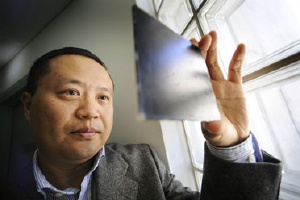May 21 2009
A newly discovered nanocomposite could vastly simplify and enhance the maintenance of large-scale infrastructure such as bridges and aircraft. QUT School of Engineering Systems senior lecturer Dr Cheng Yan said a small piece of the polymer nanocomposite with carbon nanotube fillers could be placed on various surfaces to assist as an early warning system.

"It looks like a piece of thin black sheeting but it can act as a sensor to monitor the strength of infrastructure such as bridges, aircraft, and ships," Dr Yan said.
"Large infrastructure like these must be monitored constantly for cracks, metal fatigue and warping over time so that repairs can be carried out before the damage becomes critical."
Dr Yan said the new nanocomposite sensor was light, strong, easy and cheap to install and more adoptable than many current systems.
"This new material works by monitoring small changes in strain when it is applied to crucial points on a structure such as a bridge or aircraft," he said.
"Maintenance officers can monitor changes in conductivity and can work out the strain applied to the sensor and by catching any deterioration early, save money on maintenance costs.
"It can be also fabricated as a large sensor network attached to the surface of a structure, similar to the neural system in the human body, applying to the detection of car crash and structural health monitoring for various structures."
Dr Yan is one of a team of QUT new material engineers exploring the use of nanotechnology in the creation of new materials for all industries. His recent research also includes making stronger and tougher polymers using various nano-sized fillers.
"We know that substances in their nano form change their properties. As yet we don't fully understand why this is and we are also trying to discover uses for the new properties of various materials," he said.
QUT has joined with the four other universities in the Australian Technology Network (ATN), to establish the ATN-ISTA NanoNetwork with the International Strategic Technology Alliance (ISTA) of universities in China, which has members in more than 20 universities.
The agreement allows QUT nano researchers and those from other ATN universities to partner with Chinese universities in the field of nanotechnology.